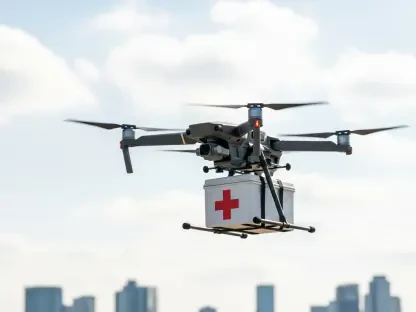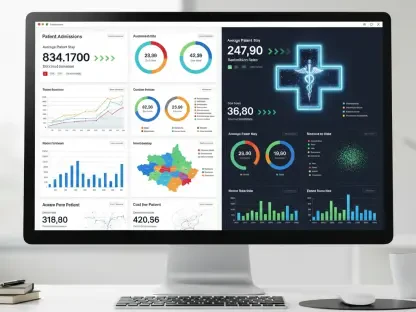Setting the Stage for a Healthcare Cybersecurity Crisis
Imagine a scenario where a single breach of digital security exposes the most intimate details of over 171,800 lives—names, medical histories, and financial records laid bare to malicious actors, creating a profound crisis in trust and safety. This is not a hypothetical situation but a stark reality that unfolded at Doctors Imaging Group, a Florida-based healthcare provider. The incident casts a spotlight on the fragility of data protection in the healthcare industry, where trust and confidentiality are paramount. It raises pressing questions about how such vulnerabilities persist in an era of advanced technology and whether the sector is prepared to safeguard sensitive information against escalating cyber threats.
The healthcare industry stands at a critical juncture, grappling with the dual demands of digitization and security. As medical records transition from paper to digital formats, providers handle vast amounts of data daily, making them prime targets for cyberattacks. Organizations like Doctors Imaging Group, which specialize in diagnostic imaging, play a vital role in patient care, managing extensive datasets that include both personal and clinical information. The reliance on electronic systems has streamlined operations but also introduced significant risks, underscoring the urgent need for robust defenses to protect patient trust and comply with stringent regulations.
Understanding the Healthcare Data Landscape
The healthcare sector operates within a complex ecosystem where data management is both a cornerstone of patient care and a persistent challenge. Millions of records containing sensitive information are generated and stored annually, ranging from routine checkups to critical diagnoses. Protecting this data is not just a technical requirement but a moral imperative, as breaches can lead to devastating consequences like identity theft or compromised medical care. The industry’s digital transformation has amplified the volume of data, necessitating advanced storage solutions and heightened security protocols to prevent unauthorized access.
Key stakeholders, including healthcare providers, technology vendors, and regulatory bodies, shape the landscape of data security. Innovations such as cloud-based storage and electronic health records have revolutionized how information is handled, offering efficiency and accessibility. However, these advancements also expand the attack surface for cybercriminals, who exploit vulnerabilities in interconnected systems. For entities like Doctors Imaging Group, balancing operational efficiency with stringent security measures remains a daunting task amid evolving threats and limited resources.
A growing reliance on digital infrastructure has made cybersecurity a top priority for the industry. Hospitals and diagnostic centers now depend on networked systems to share data across departments and with external partners, enhancing care coordination. Yet, this interconnectedness often outpaces the adoption of adequate safeguards, leaving gaps that hackers readily exploit. The scale of data handled daily highlights the critical need for proactive measures to shield patient information from breaches that can erode public confidence and disrupt healthcare delivery.
The Data Breach at Doctors Imaging: What Happened?
Timeline and Discovery of the Breach
The incident at Doctors Imaging Group began with unauthorized access to its network server between November 5 and November 11, 2024, during which sensitive files were copied by malicious actors. Suspicious activity triggered an immediate response, prompting an investigation to assess the extent of the intrusion. Despite swift initial action, determining the full scope of compromised data proved challenging, with the detailed review concluding on August 29 of this year, nearly ten months after the breach was first detected.
Official reporting to authorities occurred on September 24 of this year, marking a significant delay in finalizing the investigation’s findings. This extended timeline reflects a common hurdle in cybersecurity incidents: the complexity of analyzing vast datasets to identify exactly what was accessed. Such delays can hinder timely notifications to affected individuals, amplifying the risks they face from exposed information and complicating efforts to mitigate harm.
The prolonged process also points to systemic issues in rapid response capabilities within healthcare organizations. While the initial detection was prompt, the subsequent steps to map out the breach’s impact required substantial time and resources. This lag emphasizes the importance of having streamlined protocols in place to accelerate investigations without sacrificing thoroughness, ensuring that victims receive critical information as soon as possible.
Scope and Nature of Compromised Data
The breach exposed a wide array of sensitive information, including Protected Health Information (PHI) and Personally Identifiable Information (PII). This encompassed patient names, addresses, dates of birth, Social Security numbers, medical record numbers, admission dates, health insurance details, treatment information, and medical claim data. Such a comprehensive dataset represents a goldmine for cybercriminals seeking to exploit personal details for illicit gain.
Additionally, financial information like account numbers and types was compromised, heightening the risk of identity theft and fraud for the 171,800 affected individuals. The scale of this incident places it among significant breaches in the healthcare sector, where the loss of both medical and personal data can have far-reaching consequences. Victims may face not only financial losses but also potential misuse of their medical histories, which could disrupt care or lead to blackmail.
The magnitude of impacted individuals underscores the severity of the event and its implications for trust in healthcare providers. When data of this nature is exposed, the fallout extends beyond immediate risks to long-term concerns about privacy and security. This breach serves as a stark reminder of how a single incident can affect thousands, amplifying the urgency for stronger protective measures across the industry.
Challenges in Cybersecurity for Healthcare Providers
Healthcare systems are increasingly targeted by cybercriminals due to the high value of medical and personal data on the black market. Unlike other sectors, healthcare often lags in adopting cutting-edge security technologies, leaving many organizations vulnerable to sophisticated attacks. The combination of outdated infrastructure and the sheer volume of sensitive information creates a perfect storm for breaches, as seen in the incident at Doctors Imaging Group.
Specific challenges for entities like this diagnostic provider include limited budgets for cybersecurity enhancements and a shortage of trained personnel to manage threats. Many healthcare facilities prioritize patient care over IT investments, resulting in neglected updates to security systems that could prevent unauthorized access. Furthermore, the complexity of managing interconnected datasets across multiple platforms adds layers of risk that are difficult to address without substantial resources.
Addressing these vulnerabilities requires a multifaceted approach, including investment in advanced tools like intrusion detection systems and regular staff training on phishing and other attack vectors. Collaboration with cybersecurity experts can also help identify weaknesses before they are exploited. By prioritizing these strategies, healthcare providers can build resilience against threats, reducing the likelihood of incidents that compromise patient data and organizational integrity.
Regulatory and Compliance Implications
The healthcare industry operates under strict regulatory frameworks, with the Health Insurance Portability and Accountability Act (HIPAA) setting the standard for protecting patient data in the United States. Compliance with such regulations mandates that organizations like Doctors Imaging Group safeguard information and report breaches promptly to authorities. Failure to adhere to these guidelines can result in significant penalties and reputational damage, adding pressure to maintain robust security practices.
In the wake of the breach, the affected organization was obligated to notify both federal regulators and the impacted individuals, a process that unfolded after the investigation’s conclusion this year. This requirement ensures transparency but also highlights the logistical challenges of communicating with thousands of people while addressing the breach’s fallout. The incident illustrates how compliance is not just a legal necessity but a critical component of maintaining trust with patients.
Strengthening security policies in response to such events is essential for meeting regulatory expectations and preventing future violations. Healthcare providers must reassess their protocols to align with evolving standards, incorporating lessons from breaches to enhance protections. This proactive stance not only mitigates legal risks but also demonstrates a commitment to safeguarding sensitive data, which is vital for sustaining confidence in the sector.
Future Outlook: Strengthening Cybersecurity in Healthcare
Looking ahead, the healthcare industry must embrace emerging technologies to fortify data security against increasingly sophisticated threats. Encryption and artificial intelligence-driven threat detection systems offer promising avenues for identifying and neutralizing risks before they escalate. By integrating these tools, providers can create multiple layers of defense that protect patient information from unauthorized access over the coming years.
Stricter regulations are likely to shape the landscape, driven by incidents that expose systemic weaknesses in data protection. Alongside regulatory changes, consumer demand for transparency will push organizations to be more accountable in how they handle personal information. This shift could lead to greater public scrutiny of security practices, compelling healthcare entities to prioritize cybersecurity as a core component of their operations.
Incidents like the one at Doctors Imaging Group may catalyze industry-wide transformation, fostering collaboration between healthcare providers and cybersecurity specialists. Such partnerships can drive the development of tailored solutions that address the unique challenges of medical data protection. Over time, these efforts could establish a new standard of resilience, ensuring that patient trust is preserved even as digital threats continue to evolve.
Reflecting on a Critical Wake-Up Call
Looking back, the breach at Doctors Imaging Group served as a sobering lesson for the healthcare sector, exposing the vulnerabilities that allowed sensitive data of over 171,800 individuals to be compromised. It highlighted the devastating potential of cyberattacks to disrupt lives through the loss of personal, medical, and financial information. The incident also revealed the complexities of investigating such events, as the prolonged timeline delayed critical notifications and mitigation efforts.
Moving forward, actionable steps emerged as vital considerations for preventing similar occurrences. Healthcare organizations must invest in state-of-the-art security infrastructure and continuous training to empower staff against evolving threats. Equally important is the need for affected individuals to remain vigilant, monitoring accounts and reports for unusual activity while leveraging resources like credit freezes to minimize risks.
Beyond immediate responses, the breach underscored the value of fostering a culture of cybersecurity within the industry. Encouraging collaboration among providers, regulators, and technology experts can pave the way for innovative defenses tailored to healthcare’s unique needs. This collective approach promises to not only address past failures but also build a more secure foundation for patient data protection in the years ahead.









